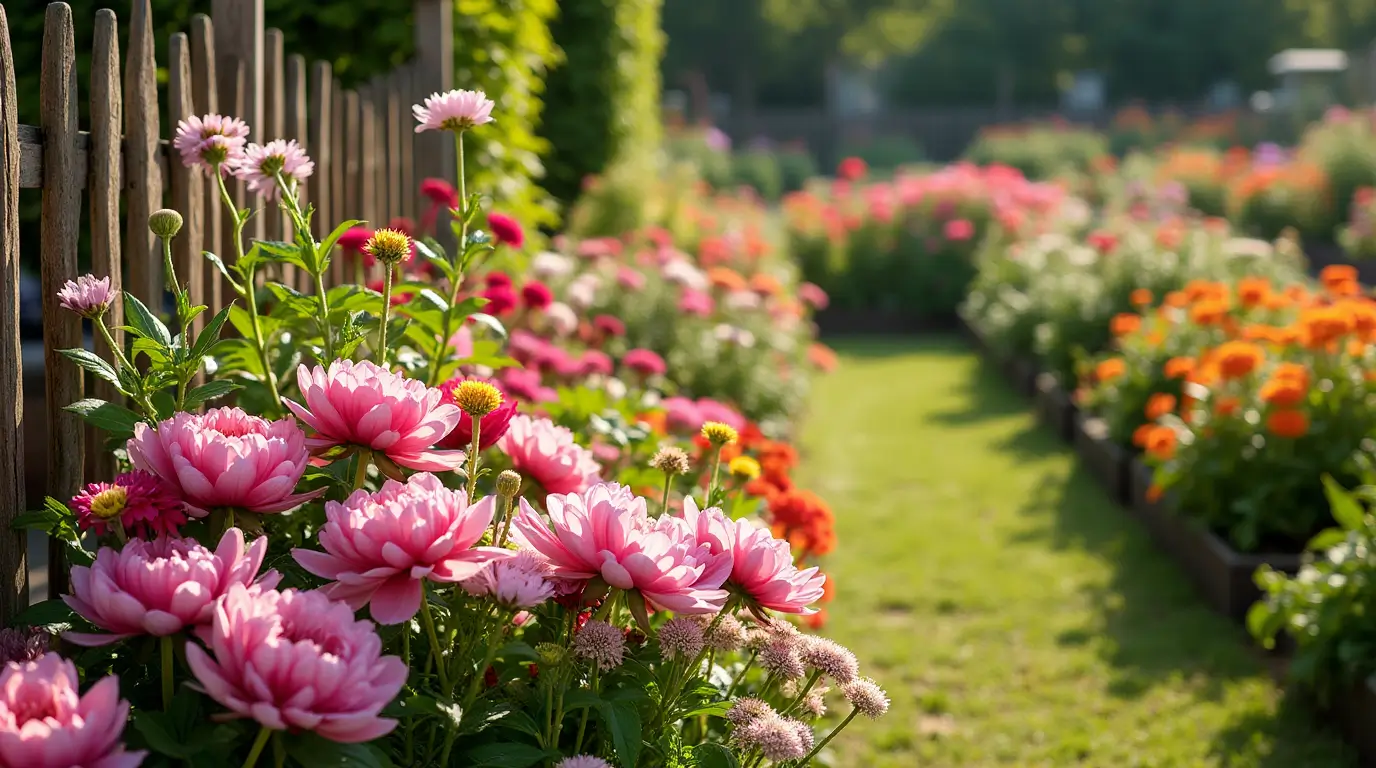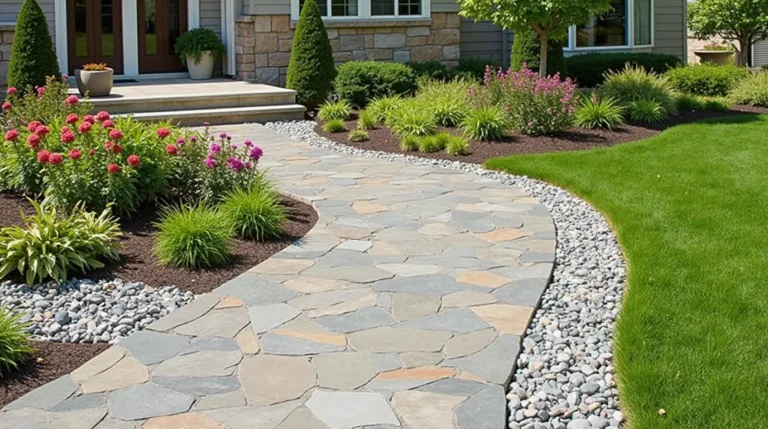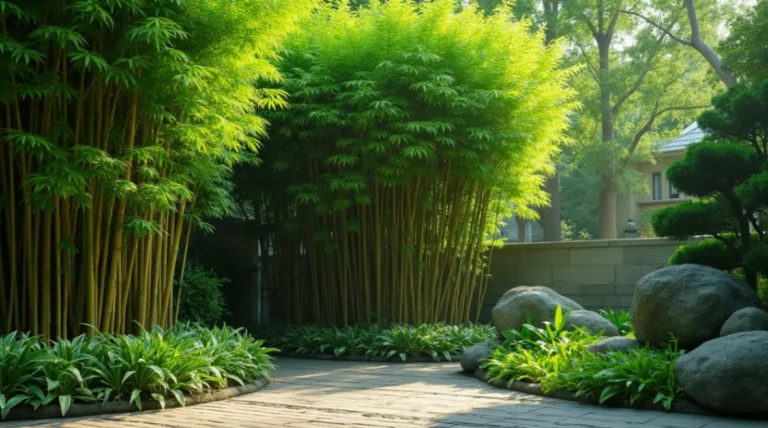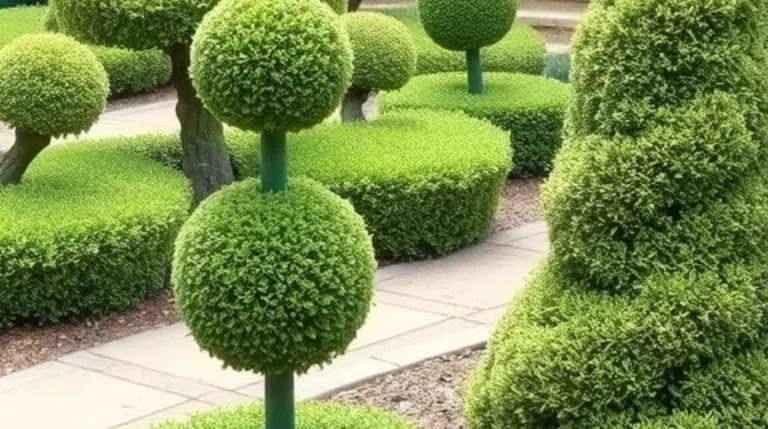Cut Flower Garden Ideas: How to Choose the Right Plants
Creating a beautiful cut flower garden needs careful planning and the right plants. A well-designed garden shows off stunning colors and textures. It also gives you plenty of fresh flowers for arrangements and bouquets.

To start, pick plants that are good for cutting and fit your local climate. By choosing the best flowers for cutting the garden, you’ll have a steady supply of fresh blooms all season.
Key Takeaways
- Choose plants that are suitable for cutting and will thrive in your local climate.
- Consider factors like bloom time, stem length, and flower color when selecting plants.
- Plan your garden layout to ensure optimal growing conditions.
- Learn how to properly care for your cut flower garden.
- Discover the best flowers for cutting and arranging.
The Magic of Growing Your Own Cut Flowers
Growing your own cut flowers is a magical experience. It brings joy and a sense of accomplishment. You get to enjoy fresh blooms in your home. This hobby connects you with nature and lets you show your creativity with DIY flower arrangements.

Benefits of Home-Grown Bouquets
One big plus of growing your own cut flowers is the variety of blooms you can use. Home-grown bouquets are fresh, customizable, and cost-effective. These benefits make it a great hobby for flower lovers.
- Freshness: Cut flowers from your garden are fresher than store-bought options.
- Customization: You can choose the flowers, colors, and scents that you prefer.
- Cost-effective: Growing your own flowers can be more budget-friendly than purchasing bouquets.
These benefits make growing your own cut flowers an attractive hobby for those who enjoy floral arrangements.
From Garden to Vase: The Satisfaction Factor
The journey from growing to arranging your own cut flowers is very satisfying. You feel proud knowing you cared for the flowers from seed to bloom. To start your cutting garden, follow these tips:
- Choose a location with suitable sunlight and soil conditions.
- Select a mix of annuals and perennials to ensure a continuous supply of blooms.
- Learn proper cutting and care techniques to extend the life of your flowers.
By following these steps, you can enjoy the rewards of a thriving cut flower garden.
How to Start a Cutting Garden: First Steps
Starting a cutting garden begins with checking your growing space and conditions. This step helps you decide what to plant and how to care for your garden. It also ensures you get the most from your harvests.
Evaluating Your Growing Space and Conditions
Knowing your garden’s conditions is key to success. You need to check the sunlight, soil, and local climate.
Sun, Soil, and Water Requirements
Most cutting flowers need full sun to partial shade. It’s important to know the sunlight needs of your plants. Soil quality is also crucial; good drainage and pH can greatly improve plant health. Water needs vary by flower type, so understanding your plants’ needs is essential.
Climate Considerations for American Gardeners
American gardeners face different climates. Knowing your local climate zone and its challenges helps you choose the right flowers and plan garden care.
Setting Clear Garden Goals and Expectations
Before planting, decide what you want from your cutting garden. Do you aim for a certain arrangement or a steady supply of fresh flowers? Clear goals will guide your plant and design choices.
Essential Tools and Supplies for Beginners
Starting a cutting garden needs basic tools and supplies. You’ll need gardening gloves, a trowel or small shovel, pruning shears, and a watering can or hose with a spray nozzle.
| Tool/Supply | Description | Importance Level |
|---|---|---|
| Gardening Gloves | Protects hands from thorns and dirt | High |
| Trowel or Small Shovel | Used for planting flowers and mixing soil | High |
| Pruning Shears | Essential for harvesting and shaping plants | High |
| Watering Can or Hose | Necessary for watering plants efficiently | High |
| Plant Labels | Helps keep track of planted varieties | Medium |

Cut Flower Garden Ideas: Designs for Every Space
Whether you have a big backyard or a small patio, there’s a cut flower garden idea for you. The beauty of a cut flower garden comes from the flowers and how you design it. It’s all about using space well and making it look great.

Small-Space Solutions: Container Cutting Gardens
Container gardens are perfect for small spaces. You can put pots on balconies, patios, or in small yards. Choosing the right containers is key. They need good drainage and should be big enough for your flowers’ roots.
Annuals like petunias, snapdragons, and zinnias do well in containers. They give you plenty of cut flowers.
Dedicated Cutting Beds: Layout and Organization
If you have more room, a dedicated cutting bed is rewarding. Plan the layout for easy access to all plants. A rectangular bed with paths is efficient. It lets you reach all areas without damaging the soil.
Grouping flowers by growing needs or bloom times makes care and harvesting easier.
Integrating Cutting Flowers into Existing Landscapes
You don’t need a special bed for cutting flowers. You can add them to your existing garden. Mixing them with ornamental plants adds variety and interest.
Think about your garden’s color and texture when picking flowers. This ensures they fit well with your garden’s look.
Unique Flower Garden Designs for Cut Flower Production
For something different, try a cutting garden maze or a garden with a focal point, like a statue. These designs add creativity to your garden.
Using both annuals and perennials makes your garden dynamic. It changes with the seasons, always giving you fresh flowers to cut.
Selecting Annual Flowers for Abundant Harvests
To get a lot of cut flowers, pick the right annuals for your garden. Annuals are key in any cutting garden, bringing color and texture all season. By choosing the best flowers, you’ll have a steady supply for your arrangements.

Top 10 Must-Have Annual Cut Flowers
Some annuals are better than others for cutting gardens. They’re beautiful, last long, and grow easily. Here are the top 10 annual cut flowers you should have:
Easy-to-Grow Varieties for Beginners
Start with easy flowers if you’re new to cut flowers. Zinnia, Cosmo, and Marigold are great for beginners. They’re pretty, easy to care for, and grow well in many places.
Specialty Annuals for Unique Arrangements
For unique bouquets, try Snapdragon, Dahlia, and Sunflower. These flowers come in many colors and make your bouquets stand out.
Succession Planting for Continuous Blooms
For constant blooms, use succession planting. Plant small batches of seeds every few weeks. This way, as one batch finishes, another starts. It works well for Zinnia and Cosmo.
Direct Sowing vs. Starting Indoors
There are two ways to plant annuals: direct sowing or starting seeds indoors. Direct sowing is simple for many plants. Starting seeds indoors gives some plants a head start. Your choice depends on the plants and what you prefer.
Best Perennial Flowers for Cutting Gardens
Perennial flowers are great for cutting gardens because they bloom year after year. They don’t need to be replanted every season. This makes them easy to care for.
Adding perennials to your garden means you get to enjoy many flowers with little work.
Long-Lasting Perennial Cut Flowers
Some perennials are perfect for cutting gardens because they bloom for a long time. Peonies are a favorite for their big, beautiful flowers. Delphiniums, lavender, and coneflowers also make great choices.

When picking perennials, think about when they bloom and how big their flowers are. This helps you choose a variety of flowers for your garden.
Early, Mid, and Late Season Perennial Options
It’s important to pick perennials that bloom at different times. Bleeding hearts and hellebores bloom early in spring. Yarrow and daylilies bloom in the summer.
Asters and chrysanthemums bloom late in the fall. This way, you always have fresh flowers.
By choosing perennials that bloom at different times, your garden will always have something beautiful to offer.
Establishing and Maintaining Perennial Cutting Beds
To make your perennial garden the best, start with good soil. Add organic matter to make it better. Plant the perennials at the same depth as in their pots and water well.
Mulching helps keep the soil moist and weeds away. This is important for keeping your garden healthy.
For ongoing care, water regularly and fertilize in the spring. Remove spent flowers to encourage more blooms. Divide the perennials every few years to keep them healthy.
Incorporating Bulbs and Tubers for Seasonal Interest
To keep your cutting garden interesting all year, think about adding bulbs and tubers. These underground plants grow beautiful flowers in many colors and shapes. They make sure you always have fresh flowers to cut.
Spring-Flowering Bulbs for Early Season Cuts
Spring bulbs are the first to bloom after winter. They include tulips, daffodils, and hyacinths. These flowers come in many colors and smells. They’re easy to care for and come back every year.
Summer and Fall Bulbs for Extended Harvests
When spring turns to summer and then fall, other bulbs bloom. Dahlias, cannas, and gladiolus are great for mid-to-late season. They have big, colorful flowers that add drama to any bouquet.
Planting and Division Schedules for Maximum Production
To get the most from your bulbs and tubers, plant and divide them at the right times. Plant spring bulbs in the fall. Plant summer and fall bulbs in the spring after the frost. Divide them when they’re crowded or after they bloom.
| Type | Planting Time | Division Frequency |
|---|---|---|
| Spring-Flowering Bulbs | Fall | Every 3-5 years |
| Summer-Flowering Bulbs/Tubers | Spring | Annual or Every 2-3 years |
| Fall-Flowering Bulbs | Spring or Summer | Every 2-3 years |
By following these tips, you can have a cutting garden that changes with the seasons. It will always give you fresh flowers for your arrangements.
Adding Structure with Flowering Shrubs and Woody Stems
To make your cut flower arrangements more interesting, think about adding flowering shrubs and woody stems. These elements not only make your bouquets look better but also help your garden stay healthy and diverse. They give your arrangements a solid base, supporting a variety of flowers and leaves.
Best Shrubs for Cut Flower Arrangements
When picking shrubs for your garden, look for ones with beautiful flowers, nice leaves, or interesting stems. Hydrangea, Viburnum, and Weigela are great choices because of their stunning flowers and flexibility in arrangements. Dogwood and Red Twig Dogwood are also good, adding color to winter bouquets with their vibrant stems.
Rhododendron and Azalea are perfect for spring with their vibrant blooms in pink, purple, and white. Mixing different shrubs ensures you always have fresh flowers for your arrangements all season long.
Pruning Techniques for Maximum Blooms
To get the most blooms from your shrubs, it’s important to prune them right. Prune after they finish blooming to remove old flowers and shape the plant. This way, you won’t lose blooms for next year.
Use sharp tools to make clean cuts and remove any dead or damaged branches. For shrubs that bloom on new wood, like Hydrangea paniculata, prune in late winter or early spring. This encourages new growth and more flowers. By pruning this way, you’ll have plenty of blooms for your arrangements and a beautiful garden.
Essential Foliage and Fillers for Complete Arrangements
Foliage and fillers are key to making your cut flower arrangements pop. They add depth and complexity. The right foliage and fillers can make your flowers shine and balance out the look.
Ornamental Grasses and Textural Elements
Ornamental grasses and other textural elements bring a unique touch. Think about adding pampas grass, fountain grass, or ferns. They create interesting textures and movements.
- Pampas grass for dramatic, feathery plumes
- Fountain grass for soft, flowing textures
- Ferns for delicate, lacy elements
Foliage Plants for Year-Round Cutting
For cutting all year, choose foliage plants with different looks and seasons. Eucalyptus, dusty miller, and hostas are great. They offer beautiful foliage for arrangements all year.
- Eucalyptus for its silvery, aromatic leaves
- Dusty Miller for its striking, silver-gray foliage
- Hostas for their versatile, shade-tolerant leaves
Herbs That Double as Cut Flower Fillers
Many herbs are also great fillers in cut flower arrangements. They add fragrance and texture. Lavender, rosemary, or chamomile can add a special touch to your bouquets.
By mixing these foliage and fillers in your cutting garden, you’ll make more complex and beautiful arrangements. They’ll show off the full beauty of your flowers.
Designing Your Cut Flower Garden for Maximum Productivity
Creating a cut flower garden that blooms all season takes planning. A well-designed garden looks great and keeps flowers coming. Think about layout, planting friends, and spacing to get the most from your garden.
Layout Considerations for Easy Access and Maintenance
A good layout is key for a productive garden. Use narrow beds for easy access. This way, you can weed, water, and harvest without stepping on the soil.
Divide your garden into sections for different flowers or plants. This makes care and harvesting easier. It helps you keep track of what needs what.
Companion Planting in Cutting Gardens
Companion planting boosts your garden’s health and productivity. Pairing flowers with the right plants can improve growth and keep pests away. For example, marigolds can fight nematodes, and basil can enhance nearby flowers’ scent.
“Companion planting is like having a good neighbor – it just makes life better for your plants.”
Choose companion plants that fit with your garden’s needs. Some, like nasturtiums, can attract pests away from your main flowers.
Spacing Guidelines for Healthy Plants
Space is crucial for healthy plants and a productive garden. Too close together means less water, nutrients, and light. This weakens plants and cuts down on blooms. Make sure to space plants based on their mature size.
- Check the seed packet or plant label for specific spacing recommendations.
- Consider the mature size of the plants, not just their size at planting.
- Leave enough space between plants for easy access and air circulation.
Good spacing helps plants grow strong and makes harvesting easier. It lets you check on your plants often and enjoy a full harvest of beautiful flowers.
Seasonal Flower Cutting Garden Tips
To keep your cutting garden thriving, adapt your strategies to the seasons. Each season offers unique opportunities and challenges. Understanding these can boost your garden’s productivity and beauty.
Spring Cut Flower Selection and Care
Spring brings renewal to your cutting garden. Tulips, daffodils, and peonies start blooming. Choose varieties with long vase life and strong stems for the best results.
Deadheading spent blooms encourage more flowers. Keep the soil moist but not too wet.
Summer Cutting Garden Stars
Summer brings warmth and lots of blooms. Sunflowers, zinnias, and cosmos add vibrant colors. To thrive, ensure your plants get enough water and nutrients.
Regular harvesting will also encourage more blooms.
Fall Flowers for Harvesting
As summer ends, asters, chrysanthemums, and dahlias keep blooming. To extend the harvest, plant in succession and support tall plants. Be ready for early frosts.
Winter Planning and Preparation
Winter is for planning and preparing. Review your garden’s past year, noting successes and areas for improvement. Order seeds and bulbs for next season and plan any garden changes.
| Season | Key Flowers | Care Tips |
|---|---|---|
| Spring | Tulips, Daffodils, Peonies | Deadhead spent blooms, maintain moist soil |
| Summer | Sunflowers, Zinnias, Cosmos | Adequate water and nutrients, regular harvesting |
| Fall | Asters, Chrysanthemums, Dahlias | Succession planting, support for tall plants, frost protection |
| Winter | Planning and Preparation | Review garden performance, order seeds and bulbs, plan garden changes |
Specialized Cut Flower Gardens for Specific Purposes
For gardeners looking to add an extra layer of functionality or beauty to their cut flower gardens, specialized designs can be a game-changer. By tailoring your garden to specific needs or themes, you can enhance your floral arrangements and overall gardening experience.
Fragrant Cutting Gardens
A fragrant cutting garden is a must for those who appreciate the sensory delight of scented flowers. Incorporating flowers like stock, tuberose, and fragrant sweetpeas can fill your home with delightful aromas. When planning a fragrant garden, consider the blooming periods of different flowers to ensure a continuous fragrance throughout the growing season.
Single-Color Themed Gardens
Single-color themed gardens offer a visually cohesive and harmonious approach to cut flower gardening. By focusing on different shades of a single color, you can create arrangements that are both striking and elegant. For example, a garden featuring various shades of white flowers, from pure whites to creamy tones, can provide a serene and sophisticated bouquet.
Butterfly and Pollinator-Friendly Cutting Gardens
Creating a garden that attracts butterflies and pollinators not only supports local ecosystems but also adds an extra layer of beauty to your garden. Flowers like zinnias, sunflowers, and cosmos are not only excellent for cutting but also attract a variety of pollinators. Incorporating a mix of annuals and perennials can ensure a constant flow of nectar-rich flowers throughout the growing season.
Drought-Tolerant Cut Flower Options
For gardeners facing water restrictions or preferring low-water gardens, drought-tolerant cut flowers are an excellent choice. Plants like lavender, yarrow, and globe amaranth are not only resilient but also provide beautiful and long-lasting blooms for arrangements.
| Garden Type | Best Flowers | Benefits |
|---|---|---|
| Fragrant | Stock, Tuberose, Sweetpeas | Aromatic bouquets, sensory delight |
| Single-Color | Various shades of a single color | Visually cohesive, elegant arrangements |
| Pollinator-Friendly | Zinnias, Sunflowers, Cosmos | Supports local ecosystems, attracts butterflies |
| Drought-Tolerant | Lavender, Yarrow, Globe Amaranth | Water-efficient, resilient blooms |
By incorporating these specialized cut flower garden ideas into your gardening practice, you can enjoy a more diverse, functional, and beautiful garden that meets your specific needs and preferences.
Essential Care and Maintenance for Thriving Cut Flowers
To keep your cut flower garden thriving, it’s crucial to understand the essential care and maintenance practices. A cut flower garden needs more than just planting flowers. It demands ongoing care for continuous blooming and healthy plant growth. Proper maintenance enhances your garden’s beauty and boosts its productivity.
Soil Preparation and Amendments
The foundation of a thriving cut flower garden begins with the soil. Soil preparation is critical for providing the necessary nutrients for plant growth. Testing your soil to determine its pH level and nutrient content is the first step. Most cut flowers prefer a slightly acidic to neutral soil pH (around 6.0-7.0).
Based on your soil test results, you may need to add amendments such as compost or well-rotted manure. These can improve soil fertility and structure.
Watering Systems and Techniques
Adequate watering is vital for cut flower gardens. The method and frequency of watering can significantly impact plant health. Drip irrigation and soaker hoses are efficient watering systems that deliver water directly to the roots.
It’s also important to water at the right time. Watering in the early morning or late afternoon minimizes stress on the plants.
Fertilizing Schedules for Maximum Blooms
Fertilization plays a crucial role in promoting healthy growth and abundant flowering. A balanced fertilizer (e.g., 10-10-10 NPK) applied at planting time and followed up with subsequent applications as per the package instructions can support continuous blooming. Additionally, side-dressing with a high-phosphorus fertilizer can encourage more blooms.
Pest and Disease Management
Regular monitoring of your cut flower garden is necessary to identify and manage pests and diseases. Common pests include aphids, whiteflies, and spider mites, while diseases can range from powdery mildew to botrytis. Using organic or integrated pest management (IPM) strategies can help mitigate these issues without harming beneficial insects.
| Practice | Description | Frequency |
|---|---|---|
| Soil Testing | Test soil pH and nutrient levels | Before planting and annually |
| Fertilization | Apply balanced fertilizer | At planting and as needed |
| Watering | Use drip irrigation or soaker hoses | Regularly, avoiding overwatering |
| Pest/Disease Management | Monitor for pests and diseases | Regularly, at least weekly |
Harvesting Techniques for Longer-Lasting Bouquets
To make beautiful, lasting bouquets, learning to harvest cut flowers is key. How you pick and care for your flowers greatly affects their life in a vase. It also impacts how they look.
Best Time of Day to Cut Flowers
The best time to cut flowers is early morning. This is when the dew has dried but before it gets hot. It helps flowers lose less water and stay healthy.
Flowers cut at this time also drink water better. This is because their stems are most full of water. For some, like dahlias, cutting in late afternoon or early evening works well too. This is because their stems are more relaxed then.
Proper Cutting Tools and Methods
Using the right tools and methods is vital for keeping flowers fresh. Always use sharp, clean tools to avoid damaging the stems. This helps flowers drink water better.
Cut stems at an angle to help them absorb water. For tough stems, like those of roses or hydrangeas, cut just above a node. Also, consider scraping or splitting the stem to help with water uptake.
Post-Harvest Care and Conditioning
After picking, it’s important to care for your cut flowers. Put them in cool water right away. This helps them drink water and stay fresh.
Adding floral preservative to the water is a good idea. These products stop bacteria and give flowers nutrients. Change the water and trim stems often to keep your bouquets fresh.
Creating DIY Flower Arrangements from Your Garden
Making DIY flower arrangements from your garden is rewarding. It adds a personal touch to your home. With simple principles and techniques, you can make your fresh flowers into stunning arrangements.
Basic Floral Design Principles
Knowing the basics of floral design is key. Balance and proportion are important. Balance is about the visual weight in an arrangement. Proportion is about the size of flowers and foliage compared to each other and the container.
- Choose a mix of flowers, foliage, and fillers for depth and texture.
- Think about the color palette and pick hues that go well together.
- Try different container shapes and sizes to find the right one.
Seasonal Arrangement Ideas
Each season offers unique flowers and foliage for arrangements. Spring arrangements often have bright tulips and daffodils. Summer arrangements might include sunflowers and dahlias.
- Spring: Tulips, daffodils, and hyacinths create vibrant arrangements.
- Summer: Sunflowers, dahlias, and zinnias add color.
- Fall: Chrysanthemums, asters, and alstroemeria bring warm autumn hues.
Preserving and Drying Cut Flowers
Preserving and drying cut flowers lets you enjoy your garden’s blooms all year. Air drying, desiccation, and pressing are simple methods.
- Air drying: Tie flowers in small bunches and hang upside down.
- Desiccation: Use silica gel or borax to dry flowers quickly.
- Pressing: Place flowers between sheets of paper to flatten and dry.
By using these principles and techniques, you can make beautiful DIY flower arrangements. They showcase your garden’s unique beauty.
Conclusion: Growing Your Cut Flower Garden Journey
Exploring cut flower gardening shows us it takes patience, practice, and trying new things. By using cut flower garden ideas and learning how to start a cutting garden, you can have fresh flowers all season.
Choosing the right plants and taking care of them is key. This includes annuals, perennials, bulbs, and shrubs. Knowing how to harvest and design your garden will help you make beautiful bouquets.
Remember, every garden is different. It’s okay to try new things and make mistakes. With time, you’ll get better at making stunning arrangements that make everyone happy.
FAQ
What are the best flowers for a cutting garden?
The top picks for a cutting garden are a mix of annuals and perennials. Think peonies, dahlias, sunflowers, zinnias, and cosmos. These flowers last long in vases and offer a variety of colors and textures.
How do I start a cutting garden?
Starting a cutting garden begins with evaluating your space and conditions. Set clear goals and gather the right tools and supplies. Choose a spot with full sun and well-draining soil. Pick flowers that bloom at different times for a steady supply of fresh cuts.
What are some unique flower garden designs for cut flower production?
For something unique, try container gardens, dedicated beds, or mix cut flowers into your landscape. You could also create a fragrant garden, a single-color theme, or a garden that attracts pollinators.
How do I care for my cutting garden?
To care for your garden, start by preparing the soil with amendments. Water regularly and fertilize as needed. Watch for pests and diseases, acting quickly if you spot any.
What are some tips for harvesting cut flowers?
Harvest cut flowers in the early morning or late afternoon. Use sharp, clean tools. Place stems in water right away. Then, condition the flowers before arranging.
How can I make my cut flowers last longer?
For longer-lasting flowers, cut them at the right stage and handle them gently. Provide proper care, including trimming stems and changing vase water.
Can I grow a cutting garden in a small space?
Yes, you can grow a cutting garden in small spaces. Use containers, vertical gardening, or choose compact flower varieties. This way, you can enjoy fresh cuts even in tight spots.
What are some perennial flowers that are great for cutting?
Perennial cut flowers include peonies, hydrangeas, delphiniums, and coneflowers. These flowers return year after year, adding beauty to your arrangements.







